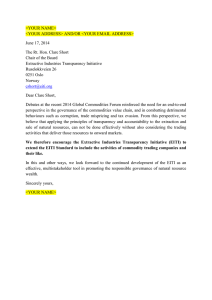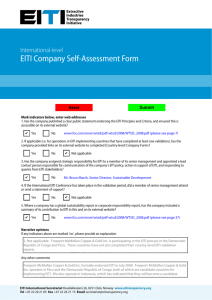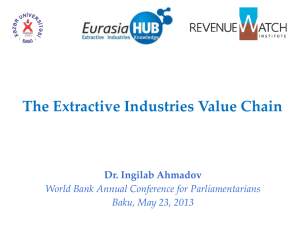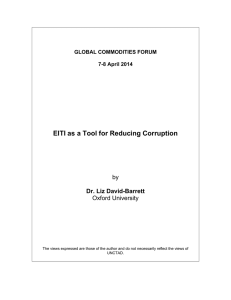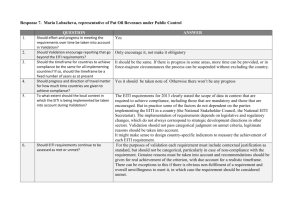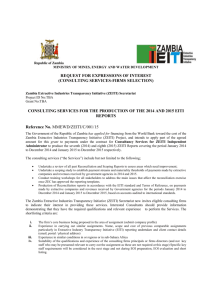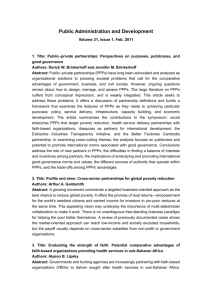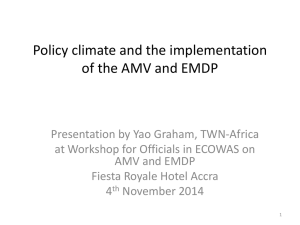DISSEMINATION AND IMPACT OF EITI NATIONAL REPORTS IN PERU SUMMARY REPORT
advertisement
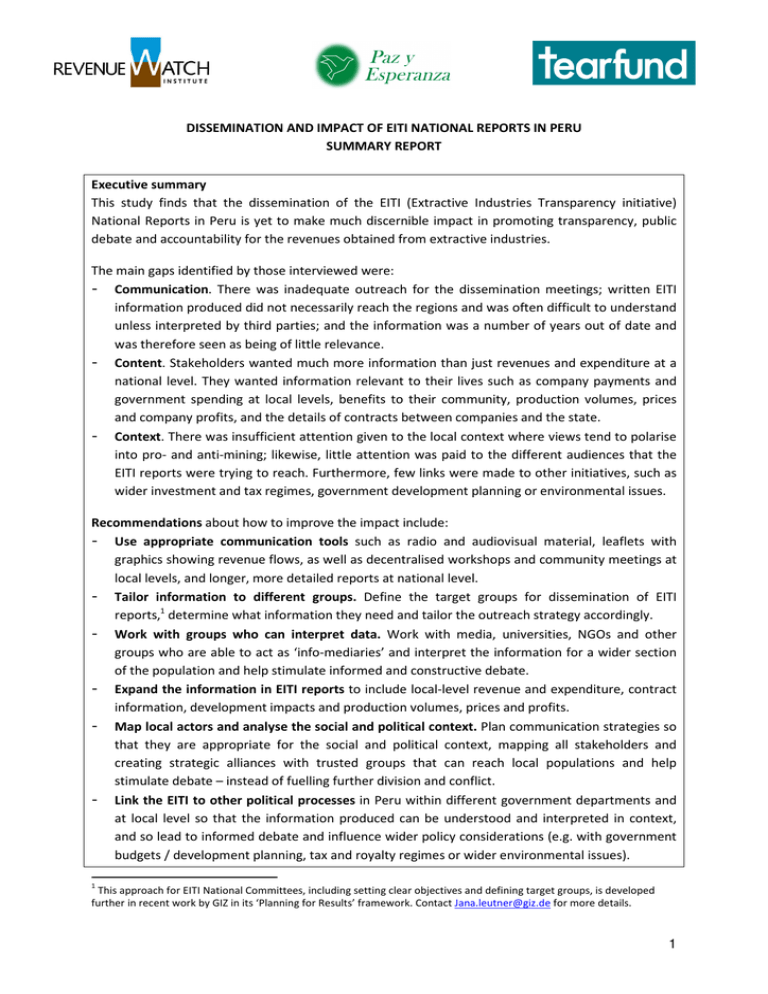
DISSEMINATION AND IMPACT OF EITI NATIONAL REPORTS IN PERU SUMMARY REPORT Executive summary This study finds that the dissemination of the EITI (Extractive Industries Transparency initiative) National Reports in Peru is yet to make much discernible impact in promoting transparency, public debate and accountability for the revenues obtained from extractive industries. The main gaps identified by those interviewed were: - Communication. There was inadequate outreach for the dissemination meetings; written EITI information produced did not necessarily reach the regions and was often difficult to understand unless interpreted by third parties; and the information was a number of years out of date and was therefore seen as being of little relevance. - Content. Stakeholders wanted much more information than just revenues and expenditure at a national level. They wanted information relevant to their lives such as company payments and government spending at local levels, benefits to their community, production volumes, prices and company profits, and the details of contracts between companies and the state. - Context. There was insufficient attention given to the local context where views tend to polarise into pro- and anti-mining; likewise, little attention was paid to the different audiences that the EITI reports were trying to reach. Furthermore, few links were made to other initiatives, such as wider investment and tax regimes, government development planning or environmental issues. Recommendations about how to improve the impact include: - Use appropriate communication tools such as radio and audiovisual material, leaflets with graphics showing revenue flows, as well as decentralised workshops and community meetings at local levels, and longer, more detailed reports at national level. - Tailor information to different groups. Define the target groups for dissemination of EITI reports,1 determine what information they need and tailor the outreach strategy accordingly. - Work with groups who can interpret data. Work with media, universities, NGOs and other groups who are able to act as ‘info-mediaries’ and interpret the information for a wider section of the population and help stimulate informed and constructive debate. - Expand the information in EITI reports to include local-level revenue and expenditure, contract information, development impacts and production volumes, prices and profits. - Map local actors and analyse the social and political context. Plan communication strategies so that they are appropriate for the social and political context, mapping all stakeholders and creating strategic alliances with trusted groups that can reach local populations and help stimulate debate – instead of fuelling further division and conflict. - Link the EITI to other political processes in Peru within different government departments and at local level so that the information produced can be understood and interpreted in context, and so lead to informed debate and influence wider policy considerations (e.g. with government budgets / development planning, tax and royalty regimes or wider environmental issues). 1 This approach for EITI National Committees, including setting clear objectives and defining target groups, is developed further in recent work by GIZ in its ‘Planning for Results’ framework. Contact Jana.leutner@giz.de for more details. 1 Introduction The activities of Peru’s oil, gas and mining sectors have been expanding significantly for almost two decades. This can be seen in the role these sectors now play in the national economy, accounting for 59 per cent of exports, growing revenues and increased investment in exploration. Mining concessions now cover 20 per cent of the national territory – approximately 21.8 million hectares. Due to the development and expansion of such projects, there has been a considerable increase in social conflicts, both at regional and local level. During 2012, the government’s Ombudsman recorded approximately 230 conflicts, more than half of which were related to the exploration and exploitation of minerals. Against this backdrop Peru was invited to form part of the Extractive Industries Transparency Initiative (EITI), and signed up in 2005. The EITI’s main objective is to promote transparency, public debate and accountability for the revenues obtained from extractive industries in implementing countries. The EITI National Committee2 in Peru has completed two national reconciliation exercises. The first contains information on payments and receipts for 2004–2007 and was published as an EITI Report in 2009, disseminated during 2010. The second, produced in 2012, contains information for 2008–2010, but has not yet been published. With this in mind, Asociación Paz y Esperanza, Revenue Watch Institute and Tearfund, alongside civil society members3 of the EITI National Committee, undertook the present study with the aim of understanding: 1) Communication: The effectiveness of the dissemination of the first EITI Report in contributing to public debate; 2) Content: The main demands made by local groups for information regarding the extractive industries; and 3) Context: The role of regional and local political dynamics and how this has been taken into consideration. Drawing on the findings of the study, the fourth section of this report suggests elements for implementing a more effective EITI dissemination strategy in Peru. It then concludes with a series of recommendations. This study focuses on the mining sector, looking at two regions in which activities were implemented to disseminate the first EITI Report: Cajamarca and Cusco. In the case of Cusco, this study focuses specifically on Espinar province. The study is based on the opinions of the actors involved in the EITI National Committee, along with representatives of local organisations and grassroots leaders from the areas in question. Information was gathered during November and December 2012 through interviews and focus groups involving a total of 26 participants.4 2 Also referred to as the Multi-Stakeholder Group or MSG Civil society organisations: Grupo Propuesta Ciudadana, ONG CooperAcción and Pontificia Universidad Católica del Perú. 4 Research carried out by Mari Burneo 3 2 The full report (50 pages, available in Spanish) contains a large number of quotes from the interviews, aimed at reflecting the concerns of the stakeholders themselves. This English summary is based on the summary in Spanish, but is arranged in a slightly different way, with more connection made to the discussions around the EITI at international level. We trust it will be useful to the National Committee and Secretariat in Peru, as well as to the International Secretariat when planning the next stages of EITI. Many of the study’s findings shed light on local expectations around the types of disclosures being considered as part of the new EITI standard, including sub-national reporting, contracts and expenditure information. 1. COMMUNICATION For the first report, the Committee commissioned a communication strategy from the Asociación de Comunicadores Sociales Calandria. The EITI Committee members who were interviewed for this study agreed that the impact of this strategy was limited in Lima, and extremely limited in the regions. In some cases, it even spread confusion where the local population had insufficient information or knowledge to be able to interpret the data provided. Some of the reasons for this low impact are explained below. Inadequate outreach for dissemination meetings In Lima, the results contained in the first report were presented at a public meeting at which 115 people were present, including specialists and state officials from the mining, oil and gas sectors. Public meetings were also organised in the regional capitals and were attended by representatives of local civil society, state officials, representatives of the extractive companies and members of EITI’s National Committee. However, there was limited publicity for regional meetings, which had uneven, often poor attendance. One of the aims of the regional-level meetings was to put the results of the first report onto the local agenda. However, according to the interviews for this study, for Cusco and Cajamarca, the meetings had no regional impact at all. One of the problems raised by interviewees was the fact that the meetings all followed the same format and yet were attempting to reach a fairly diverse audience. Moreover, the report obtained very little coverage outside the meetings themselves as no follow-up actions were organised to encourage discussion of the information presented. ‘The information has to reach the region, the provinces, the districts and the grassroots communities. So it is urgent and necessary to have this information as regards how much they pay monthly, yearly, or quarterly, at the community level. And yet we do not know, we are not informed of the contributions made by the mining companies, the extractive companies nor what the central government receives in payments each year.’ (President of the Federación Unificada de Campesinos de Espinar, Cusco) EITI information difficult to access and understand Apart from the meetings, the other main outreach activity was the production and distribution of information leaflets containing a summary of the results and general figures. According to those interviewed, the impact of this information was virtually zero at regional level as the leaflets were of 3 little use to regional or local Civil society organisations or to communities. One problem, discussed in the next section, is that there is little interest in national-level information if it is not backed up with concrete data on the companies operating locally, the government receipts they are generating and how this revenue reaches the regions and is used locally for projects. In terms of the leaflets that have been produced (see annex for more information), the one most relevant to mining is No. 4, as it sets out the main results of the first national reconciliation5 exercise. However, those interviewed felt that this was also the least clear, was not particularly user-friendly and was even confusing. Leaflet No. 4 shows that the amounts paid in income tax, royalties and surface fees, as calculated by the state for the whole period, were equal to or less than the official figures. It is not, however, clear whether this is a good indicator of transparency, whether the figures are reliable or whether they imply an inadequate distribution. In other words, the reader is left to infer many things that the leaflet should make clear if it is to fulfil its objective. In some cases, the leaflets even create speculation on other issues, such as the companies' net profits, causing yet more confusion. This is most prevalent in rural areas. Furthermore, although the leaflet indicates that the reconciliation was conducted by the consultancy firm, Ernst & Young, it does not specify that this was an independent piece of validation work, implemented under the supervision of the EITI National Committee. This also created some confusion among those who received the leaflet. In Peru, it is clear that the information disseminated by EITI needs to be accompanied by a package of information that provides some context and helps the reader understand what is to follow. This additional information could be provided by another body, or by the state itself. Untimely and out-of-date information The meetings were held in 2010 but focused on information covering 2004–2007. The information was therefore considered too dated to create any public debate or interest from the media, and this represented a major limitation. The primary reasons for this delay were: a) the lengthy discussions that took place within the EITI National Committee aimed at establishing whether the information should be presented in aggregate form or broken down by company; and b) the reporting process itself, which involved ensuring that the regulatory body provided the figures corresponding to the companies’ tax payments. Furthermore, the information was seen as out of date with respect to other more up-to-date and comprehensive information already available through one of the members of the National Committee, Grupo Propuesta Ciudadana. 5 The reconciliation exercise is done by independent auditors to compare the payments declared by companies and the revenues declared by governments and to highlight and attempt to ‘reconcile’ or account for any discrepancies. 4 2. CONTENT We have included some issues in this section that do not necessarily fall within the current scope of EITI in Peru; this is because they illustrate the gap that seems to exist between the information that local people want and the information provided in the reconciliation exercise. Although it is clear that some of the demands for information fall outside of EITI’s current objectives in Peru, the initiative runs the risk of lacking credibility, or even of becoming irrelevant, if it does not engage with these requests in some way. Demands for information from the local stakeholders The information that stakeholders want at regional and local level is varied but has a common theme: the information provided needs to be more closely and concretely linked to the local reality and to the benefits local people obtain from the company receipts. There is also a strong interest in knowing what profits the companies are making. ‘Espinar province produces copper but we don’t know how much copper is mined each day, how much investment this has required. We just don’t know; nor do we know how many tonnes are shipped each day, because no-one gives us this information. We would, of course, like to know this, and how much money the company is making every day – its profits.’ (President of the Federación Unificada de Campesinos de Espinar, Cusco) ‘Very often the local people don’t have access to this kind of information, I mean regarding the extent of the resources generated, in this case, by Tintaya, and how they generate them (...) The company never provides information on production levels, profits, prices or other information because their regulations and confidentiality requirements mean they are not obliged to provide the public with this information. Let’s hope that, with this EITI initiative, the company will allow access to this kind of information.’ (Member of the Centro Bartolomé de las Casas, Cusco) The main demands for information expressed by the local stakeholders relate to the following: • Production levels and profits on the resources being extracted. There is significant demand for information on the extractive companies’ production levels and the price of the minerals. Those interviewed wanted to know how much profit the companies are making. • Disaggregated information on the companies’ payments to the state and, specifically, how much a company pays the state, and for what purpose. The problem in presenting part of the information in aggregate form and another part itemised is that it creates suspicion and mistrust among local people towards companies working locally and towards EITI itself. • Local-level expenditure. This is concerned with how the income generated from the extractive industry is being spent locally and regionally. The study shows that people want to know not only the results of the reconciliation of company payments and their distribution to regional/local 5 governments but also how these revenues are being used, and what impact this is having in their local communities, villages or hamlets. • Benefits to local communities. Requests for this type of information come up time and again, with a need for this expenditure to be broken down by region, province, district and community. • Independent verification of production levels and prices. As noted, there is a demand for information on production levels (how much the company is extracting) and prices, and an expectation of better monitoring aimed at ensuring that the company is paying its due share. The people do not necessarily trust the state to provide this information, however, and so satisfying this demand poses an additional challenge. • Contracts. Although this issue was raised by a number of interviewees in Lima, it was not specifically mentioned by those interviewed for the report in the regions; this is in part because they are unaware of the content of such contracts in the first place and so are less able to see how contract disclosure would benefit them. This issue is, however, directly related to the previous point of lack of trust in the state to ensure that agreements with companies are in the best interests of communities. • Payments to company workers and executives. This issue was not raised frequently but was mentioned in Cajamarca. There seems to be a great deal of speculation regarding the companies’ actual profits and overheads, including payments to workers and executives. Three key needs clearly emerge from these specific issues. 1) The local population seeks information on what the extractive companies are doing in their local regions and areas. As long as the information is provided only in the form of national data – and especially if it is in aggregate form – it will appear distant and even irrelevant or of little use. 2) The local population and leaders want to know what impact the investment in extractive activities (in this case, mining) is having on their quality of life. 3) For data to be easily interpreted there is a need for sufficient information on the wider context, such as how extractive industries work and what payments they make, what benefits communities can expect and what rights they have, and how local development plans connect to mining, oil or gas activities. ‘The EITI only [plays a role of] informing and disseminating, but many people ask us what use this reconciliation is if it goes no further than making recommendations; a number of people have asked us what point there is in Peru being a compliant country if this has no impact on conflict resolution. The information it provides is important but people want this grounded in concrete proposals.’ (Participant in focus group, Cajamarca) 3. CONTEXT One of the most significant findings of the research was the importance of understanding the context in which the EITI work is developing in Peru. As mentioned in the introduction, this context includes increasing investment by mining companies, as well as increasing social conflict over mining operations and a population that is polarised into ‘pro-’ and ‘anti-’ mining camps. The research 6 findings show that the lack of analysis of the context and the lack of links with other initiatives severely undermined the potential impact of EITI reports in Peru. Lack of understanding of the context In the areas where the extractive industries are present, figures on payments and receipts are not necessarily assumed to be transparent and legitimate simply because they come from a tripartite body, in this case the EITI Secretariat. This is due to a number of reasons, one of which being that the state is not always seen as an impartial body but is instead perceived as being ‘on the side of the companies and not the people’. This perception is all the more acute in areas where social conflict is emerging around specific projects, as in Cajamarca and Espinar/Cusco. Such conflicts tend to create highly polarised regional and/or local scenarios in which the different positions with regard to (in this case) mining tend to solidify into two groups: those who are for and those who are against. This undermines the credibility of the report and of EITI itself which, on more than one occasion, has been perceived more as a private-sector initiative aimed at improving the companies’ image and facilitating their investments. ‘EITI was viewed as a mining company whitewash, something that was supporting the company. So we had to explain that this was not the case, that it was a transparency initiative that did involve the company but not only the company.’ (Participant in focal group, Cajamarca) ‘Many interests are at play in the mining context; the problem is that mining itself contributes to this in some way, that’s how I see it, feeding these kinds of divisions and conflicts. EITI needs to be very careful that these groups don’t use this as a way of feeding into their protests or protecting their interests.’ (Member of the CEDEPAS Norte team, Cajamarca) From this perspective, the EITI’s challenge in the Peruvian context goes beyond simply disseminating the reconciliation results adequately; there is a need to establish a public debate around political issues, starting with the role of the state itself in the EITI National Committee, and what the process of reconciling the figures means. A more active presence on the part of reputable universities, as well as local or national media, could significantly help to establish the EITI’s objective and underline its neutrality. Coordinating the EITI with other issues on the social and political agenda The EITI could attempt to coordinate with institutions that are already conducting similar work in the regions, and with local grassroots organisations – such as monitoring committees. This would help ensure that information is more specific and targeted and goes beyond simply documenting the distribution of receipts to regional/local governments to detailing how this revenue is used. It is also important to create links between the EITI and organisations that have information on extractive industry concessions. Data from the EITI could thus be supplemented with other kinds of information for which there is demand, such as information on local government budgets, using 7 existing information platforms to boost the scope of the EITI without the need to widen its specific objectives. The study also revealed a number of local public agenda issues that are related, directly or indirectly, to the information provided by the EITI. The issues noted in the field include some that go beyond the EITI's core scope but which are important for the population with regard to extractive activities. Examples include the granting of exploration permits and increasing number of concessions, and even issues related to monitoring compliance with the socio-environmental standards and criteria established in Environmental Impact Assessments. Furthermore, one of the challenges to be addressed seemed to be a lack of clarity among the wide range of stakeholders about exactly what the EITI could and should do, leading to unrealistic expectations and an unfocused communications strategy. Finally, further exploration of the way the information provided in the EITI Report is perceived raised a series of public management issues that are inevitably linked to issues of interest to EITI: - The dissemination of development plans to regional and local governments and their coordination with other management tools; in theory, the spending of revenues from the extractive industries should be linked to these plans, and yet they contain no mention of this and no connection is established between the two. - The need for greater capacity to produce investment project profiles; this is an ongoing issue related to Peruvian decentralisation and it was voiced as a constant concern in the interviews. - The need for greater capacity to implement public investment projects that are going to have an impact on local development; this demand was frequently raised by grassroots leaders interviewed in Espinar. - The importance of participatory budgeting as a space in which the use of revenues can be agreed and training on the issue conducted. Those interviewed indicated that this space was not sufficiently used to clarify the parameters of how payments could be used, nor was it used to reach a consensus on the actual use of these receipts; they indicated that ‘pre-approved’ projects were normally passed, with little scope for debate. - The use of mining royalties and payments for universities. Some of the interviewees felt this had been overlooked and that there was little interest in the region in this regard, even among the universities themselves, in part through a lack of awareness of the issue. 4. PROPOSAL FOR KEY ELEMENTS OF A DISSEMINATION STRATEGY The fourth part of this report focuses on the suggestions and experiences of those interviewed. It offers criteria for producing a more effective communication strategy. The overall aim is to strengthen the EITI’s impact and its contribution to transparency and accountability processes, as well as to the national public debate.6 6 This is also linked to the need for National Committees to set clear objectives about what they want to achieve, and who are the main target audiences for the reports – an idea that is developed much further by GIZ in its ‘Planning for Results’ framework. 8 4.1 Strategies for communicating the information - Appropriate mechanisms and spaces for information dissemination Mechanisms and spaces for dissemination need to be adapted to the different sectors and appropriate to the target audience for the report, which will differ according to country, region and context. The local actors interviewed in Espinar-Cusco and Cajamarca all agreed that the best way of transmitting short pieces of information was to use radio broadcasts and short publicity announcements in the local language. The people interviewed in Cusco and Cajamarca also felt that the information leaflets could be useful for accessing information rapidly but that they had their limitations. They felt that leaflets were more acceptable than documents stretching to several pages; these latter are more useful in an urban context than a rural one. Leaflets work with a target audience of local officials and grassroots leaders but their language is not accessible for the grassroots urban, let alone rural, population. All those interviewed suggested that the leaflets should contain clearer and simpler graphics, drawings and flowcharts providing specific information. The local actors interviewed indicated that people would be very interested in receiving audiovisual material. It is not simply a question of broadcasting on local TV channels, as these are generally only accessible in urban areas; instead, they suggested that DVDs should be produced with dramatised content, presenting the information in a more creative way. In terms of the spaces in which the information should be presented and disseminated, decentralised workshops are another important way of engaging local leaders but not of reaching the grassroots population. A workshop is usually held in the provincial or district capital and thus has little impact on rural residents. Interviewees therefore proposed decentralising the workshops by holding them at community level. The importance of having a bilingual facilitator at these workshops should be noted, and the radio broadcasts should always be in the local language, with the leaflets in Spanish. - Differentiate between the groups receiving the information and diversify its presentation One factor that stood out among the strategies proposed by local stakeholders in terms of ensuring a wider dissemination of the results of EITI‘s national reconciliation exercise was the need to better differentiate between the groups receiving the information. Some distinct target groups would include: 1) national and local authorities and officials; 2) universities; 3) journalists; 4) grassroots leaders; 5) national, regional and local opinion leaders; and 6) grassroots communities and the public in general, which could include other national-level target groups. - Short courses could be run for local authorities and officials in order to enhance their capacity to ‘read’ the technical information contained in the reconciliation reports. - Consideration should also be given to generating interest in the reports among the universities established in provinces with mining concessions and exploration/exploitation projects, and which receive 5 per cent of the mining royalties. - It is important to take into account the way local media are produced and used. This means ensuring that the products to be disseminated via the media are culturally appropriate. - Universities and local media, as well as many NGO groups, can act as what have been called ‘infomediaries’, that is groups that can take complex information and make it understandable and relevant for a wider audience. 9 - The best communication strategy for grassroots leaders would be to hold workshops of the kind mentioned above. For grassroots communities and the general public, those interviewed felt that it would be important to use spaces specific to the local context, for example, local trade fairs. 4.2 Content of EITI reports Given the demand for information by those interviewed in this study, it is clear that the EITI in Peru needs to consider providing a much broader range of information relevant to the operations and impact of oil, gas and mining companies. This should include: - Production levels and profits made on the resources being extracted. - Disaggregated information on companies’ payments to the state at all levels, including projectlevel information. - Local-level expenditure by national, regional and local bodies of revenue from extractive industry operations. - Benefits of natural resource revenues to local communities in terms of infrastructure, social projects, jobs etc. - Independent verification of production levels and prices to ensure that each company is paying its due share. - Details of contracts and licences. 4.3 The importance of producing communication strategies and strategic alliances that take account of the local and regional political situation. One overarching issue in discussing information mechanisms and spaces is the need for better analysis of the local and regional context prior to designing a communication strategy. It is important to produce a map of all stakeholders involved, along with their institutions and organisations, and their relationships and links, both locally and beyond. The tensions and polarisation of opinion in some scenarios may seriously affect both the credibility of the information to be disseminated and how it is received. Those interviewed stated that it was important to create strategic alliances with different local and regional organisations and institutions as part of the communication strategy, in order to ensure that EITI Peru’s work does not duplicate initiatives but is instead integrated into the agendas of existing institutional platforms. EITI also enables discussions to be initiated on the need for local and regional governments to take responsibility for disseminating information and providing training to help people understand what the payments are and what the royalties and surface fees consist of, as well as how they are calculated and distributed. The same applies to central government bodies – such as the Ministry of Energy and Mines (MEM). In other words, although EITI can disseminate the results of the reconciliation, the effect will be limited if local people are unaware of basic issues relating to the distribution and use of government receipts from extractive activities. Under such circumstances, the information in the EITI Report lacks relevance for affected communities. A link needs to be made between the information generated by EITI and the local/regional dynamic. Otherwise, even an excellent communication strategy (albeit limited to disseminating the results of the reconciliation) will have little or no impact on the population. 10 SUMMARY OF RECOMMENDATIONS Communication strategy - It is essential that the EITI National Committee in Peru creates a mechanism to ensure the provision of up-to-date information, to overcome the time lag between the period covered in the reconciliation exercise and the publication of the EITI Report. - The following aspects need to be considered in a regional/local communication strategy: - Identify the platforms that are coordinating regional institutions and multi-sectoral work committees, thematic networks etc, to ensure coordination of dissemination activities. - Identify and make use of any public spaces already existing at local level, as these can be used for information dissemination (trade fairs, community-level meetings, etc). - Take the diversity of local contexts into account; this means designing materials that are adapted to different groups with different ways of communicating and interacting. A set of dissemination mechanisms needs to be designed that will combine the use of radio in the local language with audiovisual and printed materials. - In the case of printed materials, the content of information leaflets must take the literacy level of local people into account and make full use of pictorial elements such as graphics, images, flow charts, etc. Content of reports - Include itemised information for all EITI-affiliated companies in the reconciliation report. If not, this will only create confusion among the public, along with suspicion and mistrust that will damage public perceptions not just of companies failing to provide this information but also of the EITI initiative in general. - Extend the scope of information so that it provides data on the distribution, use and impact of expenditure of revenue generated. - Given that one of the greatest demands for information at regional/local levels relates to the extractive companies’ profits and production levels, the EITI National Committee should consider the relevance of providing some information on these issues. - Make EITI information more relevant to the local people. The conclusions of this study show that there is no clear link made between the information provided by the reconciliation exercise and its impact on people’s quality of life. This can be done by promoting an understanding of the ‘extractive revenues route’ – so that the size of these payments to the state is linked to expenditure at local level – and of their impact on the quality of life locally. This will require greater effort in terms of designing indicators of impact assessment. Social and political context - The EITI needs to position itself as an institution in the public sphere. The information that the EITI provides is important and it is therefore necessary to ensure the EITI’s legitimacy as an initiative that seeks to reconcile and improve the transparency of information coming from the extractive industries. The idea needs to be reinforced that the EITI is not a body set up by the Ministry of Energy and Mines but rather is a tripartite state, private sector and civil society initiative. In this regard, it is important to emphasise the involvement of institutions enjoying a high degree of legitimacy in the public perception, such as universities. This will contribute to the idea that the reconciliation is of value in its own right and contributes to greater transparency. 11 - - - Insofar as the aim is for the information in the EITI Report to have a social and political impact that will influence the public debate, it is recommended that the EITI National Committee gives the task of creating the communication strategy to a body with good knowledge of the local context and proven skills in conducting political analyses of local and regional contexts, with an emphasis on the rural environment. Differentiate between the various target audiences and produce materials accordingly. It is recommended that the EITI National Committee has an advocacy plan that has clear objectives and identifies which groups are the main target readership for the EITI reports. It is suggested that it considers the following groups as a minimum: political decision-makers and national government officials; local authorities and officials; opinion leaders; specialists in the sector and researchers; regional and local journalists; leaders of grassroots organisations at regional/local level; the grassroots communities and public in general. It is recommended that EITI seeks ways of coordinating with the initiatives of bodies or institutions external to the Committee, which are working on issues that are possibly beyond the scope of EITI’s work but that could boost the impact of the results of the reconciliation exercises. 12 Annex: materials consulted - Aide-Mémoire from the 1st EITI-Peru Forum in Moquegua - Aide-Mémoire from the 2nd EITI-Peru Forum in Huaraz - Aide-Mémoire from the 3rd EITI-Peru Forum in Iquitos - Aide-Mémoire from the 4th EITI-Peru Forum in Cusco - Aide-Mémoire from the 5th EITI-Peru Forum in Cajamarca - Aide-Mémoire from the 6th EITI-Peru Forum in Lima - Information leaflet Nº 1 EITI-Peru: A commitment to transparency - Information leaflet Nº 2 EITI-Peru: Origin, distribution and use of revenues from mineral extraction - Information leaflet Nº 3 EITI-Peru: Origin, distribution and use of revenues from oil and gas extraction - Information leaflet Nº 4 EITI-Peru: Transparent mining accounts. EITI-Peru national reconciliation exercise - Information leaflet Nº 5 EITI-Peru: Transparent oil and gas accounts. EITI-Peru national reconciliation exercise - Information leaflet Nº 6 EITI-Peru: A commitment to transparency: the story so far - Grupo Propuesta Ciudadana (2011) Cusco: mining and gas. Reconciliation of payments and receipts for gas and mining taxes and royalties, 2011. - Grupo Propuesta Ciudadana (2011) Cusco: generation, distribution and use of revenues from gas and mining - Grupo Propuesta Ciudadana (2011) Cusco: mining and gas. Reconciliation of payments and receipts for mining and gas taxes and royalties. Transparency report - National reconciliation exercise for the Cajamarca regional level, 2010 - EITI-Peru (2009) First national reconciliation report For more information, please contact: Graham Gordon, Tearfund (UK): graham.gordon@tearfund.org Erica Westenberg, Revenue Watch Institute (US): ewestenberg@revenuewatch.org Carlos Monge, Revenue Watch Institute (Peru): cmonge@revenuewatch.org Rolando Pérez, Paz y Esperanza (Peru): rperez@pazyesperanza.org 13
